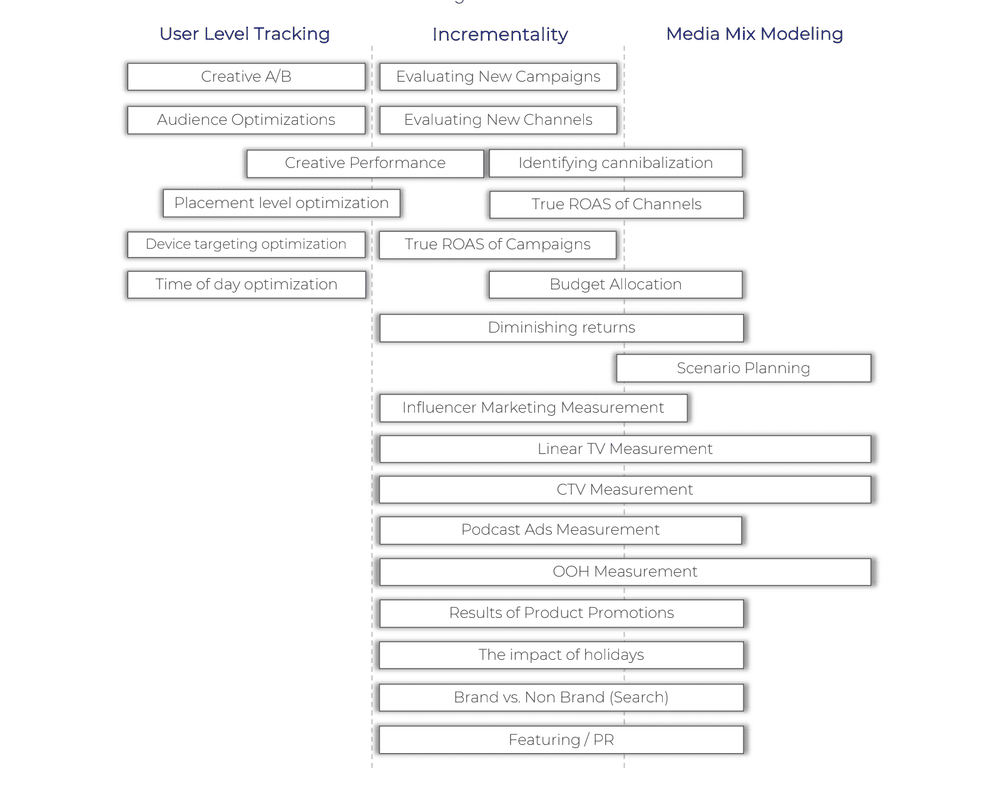Solutions
Teams
Built for your whole team.
Industries
Trusted by all verticals.
Mediums
Measure any type of ad spend
Platform
Use Cases
Many Possibilities. One Platform.
AI and Automation
The Always-on Incrementality Platform
Teams
Built for your whole team.
Industries
Trusted by all verticals.
Mediums
Measure any type of ad spend
Use Cases
Many Possibilities. One Platform.
AI and Automation
The Always-on Incrementality Platform

In recent years, Media Mix Modeling (MMM) has experienced a resurgence, becoming a trending topic in the world of adtech and martech. Despite its newfound popularity, many advertisers have found themselves disillusioned with its effectiveness. We want to explore this phenomenon, looking at the rise and fall of MMM, its advantages and limitations, and how there are other more modern alternatives.
Media Mix Modeling (MMM), also known as Marketing Mix Modeling, is a statistical technique used to assess the impact of different marketing tactics on sales. This method, developed in the 1950s, helps in forecasting and developing improved marketing strategies to achieve incremental growth. It works by modeling correlations between marketing activities and sales results.
MMM helps answer what will happen if you make specific changes by capturing both controllable and uncontrollable marketing influencers. It aids in building a predictable marketing strategy, allowing for the testing and validation of assumptions. Creating a Marketing Mix Model requires a strong bias towards your own products - having a detailed knowledge of product pricing, planned changes, promotions, budget, and past sales performance. Although frameworks exist, MMMs must be customized for each company's unique products and plans.
This method gained attention in the digital age due to its ability to function without requiring user-level data, making it attractive in an era of increasing privacy concerns. With the rise of privacy regulations, such as GDPR and ATT, marketers sought methods that did not rely on user-level data. MMM seemingly fits this need, offering insights based on aggregate data and statistical correlations.
MMM’s strength lies in that it’s an excellent tool for scenario planning. It allows marketing executives and CFOs to simulate various marketing strategies and forecast their potential outcomes. This high-level perspective can be invaluable for strategic decision-making and budget allocation. However, MMM falls short when it comes to execution and practical application. Over the last three years, spurred by changes like the introduction of ATT and the deprecation of the IDFA, hundreds of advertisers tested MMM. Unfortunately, many found the results to be unsatisfactory and confusing, not completing the MMM calibration process.
Advertisers that tested this method under the new privacy changes often faced the same issues. Below is a list of the most common challenges.
1. Inconsistent Results : Advertisers often found that two channels with different spending levels would yield the same value in the model, leading to perplexing and unreliable insights.
2. High Cost of Testing: Validating a new channel required significant spending over a long period, making it an impractical option for many advertisers.
3. Limited Scope: Advertisers could only test one variable at a time, limiting the ability to optimize across multiple factors simultaneously.
4. Difficulty in Validation: Trusting MMM predictions was challenging. Validating an MMM is extremely difficult as it requires trusting a future prediction that “if you do this – that will happen” in a world where the number of variables influencing performance is unfathomable.
5. Only High-Level Insights: MMM provided broad insights that were not actionable or operational, failing to meet the needs of performance advertisers seeking detailed, real-time data.
6. Historical Data Requirement: Substantial historical data is needed for MMM to be effective, posing a challenge for advertisers operating in multiple countries with varying data availability. Making it quite unattainable for many advertisers
7. Stability Requirement: MMM struggles with handling constant and frequent changes in marketing activities, making it unsuitable for fast-moving marketing teams.
8. Granularity Limitations: The insights typically only reached the channel level, not the campaign or ad group level, limiting detailed analysis.
The irony lies in the fact that the advertisers who benefited from MMM in the past are still the ones who benefit today. MMM was never designed for the fast-moving performance marketer who operates across numerous advertising channels and requires real-time optimization of bids, creatives, and campaigns.
At INCRMNTAL, we recognize the limitations of MMM but we are not anti-MMM. Our method is different and has been successfully adopted by hundreds of advertisers. While our platform is often compared to MMM, there is no straightforward bucket to place INCRMNTAL in.

Our opinion on MMM is positive when used responsibly and for the right reasons. Our white paper, "Orchestrating Measurement", discusses the value of triangulating measurement and highlights where MMM can be useful, provided it is employed by the right advertiser for the right purposes.
MMM has its place in the marketing analytics toolkit but is not a one-size-fits-all solution. Advertisers must understand its limitations and use it in conjunction with other methods for the best results. At INCRMNTAL, we offer a modern, flexible alternative that meets the needs of today's fast-paced, data-driven marketing landscape. We invite you to explore how INCRMNTAL can enhance your marketing measurement and strategy.

Maor is the CEO & Co-Founder at INCRMNTAL. With over 20 years of experience in the adtech and marketing technology space, Maor is well known as a thought leader in the areas of marketing measurement. Previously acting as Managing Director International at inneractive (acquired by Fyber), and as CEO at Applift (acquired by MGI/Verve Group)